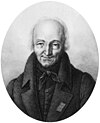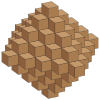Talk:Timeline of crystallography
| This article is rated List-class on Wikipedia's content assessment scale. It is of interest to the following WikiProjects: | |||||||||||||||||||||||||||||||
| |||||||||||||||||||||||||||||||
Ewald Prize timeline entries[edit]
@VaudevillianScientist: I am considering removing all but the first of the 13 timeline entries for Ewald Prize winners for the following reasons:
- There is a new article for the Ewald Prize which lists all the winners.
- The timeline is now very long and could do with some cutting down, and the Ewald prize entries tend to be somewhat longer than the average.
- The dates of the awarding of the Ewald prizes are often much later than the dates of the crystallographic work that they were based on. This is because, in many cases, the prize is awarded for lifetime achievement in crystallography. This makes the date given in the timeline somewhat misleading.
- For Nobel prize winners I make two entries, one in the year of the discovery, and another in the year of the Nobel prize award. This would be more difficult to do with Ewald prize winners as often there is no specific single date of a major discovery or invention.
I would be grateful for your view on these proposed changes. GreatStellatedDodecahedron (talk) 13:59, 14 March 2024 (UTC)
- @GreatStellatedDodecahedron, I agree with your proposed changes. Thanks for consulting me on the matter. I'm not too worried that the timeline article is getting longer. The prizes are better placed in their own lists because they are more about the award date than the discovery date. In addition to the Ewald prize, I think the timeline page can include a list of Nobel prizes related to crystallography as a sublist. VaudevillianScientist (talk) 05:02, 25 March 2024 (UTC)
History of crystallography[edit]
@VaudevillianScientist and Ldm1954: Wikipedia doesn't have an article on the History of crystallography. As we are the three main contributors to the Timeline of crystallography article, would you be interested in collaborating on such an article?
I would propose to use the following as the main sources: Authier[1], Ewald[2] and Lima-de-Faria[3].
As to division of the work, I would be happy to take the pre-x-ray period, if you two could cover the post-x-ray period. Please let me know what you think about the proposal.
Regards, GreatStellatedDodecahedron (talk) 12:37, 7 May 2024 (UTC) GreatStellatedDodecahedron (talk) 12:37, 7 May 2024 (UTC)
- I am more familiar with the electron components. Thinking about this, I would want to first split (using sandbox directories) the current page in four:
- 1) Crystallography in it's pure form
- 2) X-ray crystallography
- 3) Electron crystallography
- 4) Neutron (and perhaps dft & NMR)
- For instance all of pre X-ray is in 1) as are others such as quasicrystals, aperiodic and (maybe) direct methods. Bragg, proteins etc go in 2). Parts of what are currently in 3) are minor, and many big things (first atomic images, Cs correction) are missing. Section 4) on neutron & NMR (?) are outside my expertise.
- I think 1) & 2) are certainly large enough for articles. 3) is very political, but I can handle that (my skin is thick enough) and I am infamous enough.
- N.B., I will be slow as I am currently ovecommitted. Ldm1954 (talk) 13:21, 8 May 2024 (UTC)
- @Ldm1954:Thanks for your response. I will make a start on 1) at User:GreatStellatedDodecahedron/History_of_crystallography_before_x-rays, as time allows. GreatStellatedDodecahedron (talk) 22:06, 9 May 2024 (UTC)
- Please note that your title is not my suggestion. In 1) goes quasicrystals, aperiodic and maybe direct methods. It would go from year dot to now. I was also proposing first splitting the list and rationalizing it before trying to write something. Currently it is heavily X-ray and protein oriented, with unbalanced EM and almost no neutron. Ldm1954 (talk) 12:51, 10 May 2024 (UTC)
- I think we need to discuss our overall approach a bit more. If I understand you correctly you are proposing to take the existing entries in the Timeline of crystallography, divide them into four crystallographic areas (pure, x-ray, electron and neutron), rationalize the entries, and then write four articles based on the existing entries plus some additional material.
- My thinking is a little different. I am envisaging a mixed approach, with two chronological, illustrated articles:
- History of crystallography before x-rays (to 1911)
- History of crystallography in the twentieth century (1895-2000), which would include developments in pure crystallography such as quasicrystals, aperiodic and maybe direct methods, and a high-level summary of x-ray, electron and neutron crystallography
- plus three more detailed subject area articles:
- History of x-ray crystallography (1895-)
- History of electron crystallography
- History of neutron crystallography
- GreatStellatedDodecahedron (talk) 16:03, 10 May 2024 (UTC)
- My thinking is more to first decide what goes in and that does not. At the moment I view it as somewhat disorganized. Articles, if desired, come later. For instance:
- Why is piezoelectricity & the Curie's included
- Which structure solutions are major enough to include -- not all
- Are polytypes of SiC that notable
- Menter's first HREM, O'Keefe etc al structure imaging, Albert Crewe STEM, Marks & Smith nanoparticles (COI), Cs correction all missing
- LEED, massive oversight
- That a FEL started working is a dubious inclusion
- Why is Olex2 included
- Gonen MicroED should definitely be removed. Strongly contested work, not accepted in wider EM community.
- Can't include AET of Miao and ignore all the Z-contrast etc of others
- Not the best refs for Staff
- No mention of CBED
- Similar to WP:N, what makes something notable enough to include here? I think some
- @Ldm1954:You are definitely in a better position than me to decide what content should be included/excluded in the Timeline article, and the yet-to-be-written History article(s). I would not question any changes you wanted to make based on your professional experience as I only have a chemistry degree and have never been a crystallographer. So if you want to go ahead and split out the entries into the 4 areas, and address the other points you have made, then by all means please do so.
- However, my feeling is that writing a History of Crystallography article will force me to go outside the current entries in the timeline in order to tell a historically accurate, joined-up story.
- For example, there are 4 entries relating to René Just Haüy in the Timeline. In a History article I think it will be more natural to combine all of these events into one or more paragraphs examining the development of Haüy's ideas throughout his career. Haüy will need to be placed into the context of his times and his contemporaries. We need to answer the question: why was Haüy important in the historical development of crystallography? We will probably also include a portrait of Haüy, and one of his images showings how the external form of a crystal can be constructed from many, small units. Fortunately the existing article on Haüy is pretty good.

 GreatStellatedDodecahedron (talk) 14:02, 11 May 2024 (UTC)
GreatStellatedDodecahedron (talk) 14:02, 11 May 2024 (UTC)
- For the timeline article, some key theory (e.g. by Hans Bethe, Norio Kato) and reconstruction algorithm developments are missing. I'm a bit confused about the discussion chain here, but here are some replies to preceding discussions.
- SiC polytypes are important. It's a prototypical system and the most studied (and most understood) among polytypes to date.
- FEL starting dates are milestones. These are X-ray FELs that serves the general crystallography community, not the prototypes that were constructed for internal feasibility demos only. The earliest operational FEL goes back to the late 1970s but its significance to crystallography is very little, therefore not worthy of mentioning. Perhaps the links to first published results relating to FEL-based crystallography could be included along with the FEL starting dates. Reference will be needed for them. What's also missing currently are the initial works using synchrotron X-rays.
- I think the judgements on AET and MicroED should be neutral per platform policy. If they are not the only contemporary methods, then competitor methods may be presented in tandem. @Ldm1954
- Crystallography of disordered materials and high pressure crystallography are pretty much absent.
- Regarding the history article, there is a decent example (History of statistics) of the same type available for comparison. Statistics is also a young-ish field (< 150 years old), but I clearly have my personal bias in choosing this. I'm happy to contribute to the the history article, but haphazardly rather than with a dedicated section assignment. The section division you proposed sounds fine, but I think there should be another section on the combination of physical theory, reconstruction methods/software, and databases. The field of crystallography is critically driven by these developments. I think calling this section Theory and algorithms would be fitting. VaudevillianScientist (talk) 02:50, 12 May 2024 (UTC)
- The reason why I want to do sections is Sandbox organization. Currently I cannot readily see what is missing because it is a jumble of different topics. If we separate it out in Sandboxes (not to the world) at least we can see. Ldm1954 (talk) 03:40, 13 May 2024 (UTC)
- Please look at User:Ldm1954/Sandbox/EC, which is the current electron crystallography pieces alone. This is for discussion/organization, but it may be useful for adding to. If you do, please use something like ** to mark it. Ldm1954 (talk) 04:00, 13 May 2024 (UTC)
- I am away at present, but will have a look when I get back on Friday GreatStellatedDodecahedron (talk) 21:30, 13 May 2024 (UTC)
- I think your division for electron crystallography is fine, and could form a good basis for a History of electron crystallography article. Would you like me to have a crack at dividing up the other entries in the Timeline into separate sandboxes for pure crystallography, x-ray crystallography and nmr/neutron crystallography? GreatStellatedDodecahedron (talk) 20:30, 17 May 2024 (UTC)
- My thinking is more to first decide what goes in and that does not. At the moment I view it as somewhat disorganized. Articles, if desired, come later. For instance:
- Please note that your title is not my suggestion. In 1) goes quasicrystals, aperiodic and maybe direct methods. It would go from year dot to now. I was also proposing first splitting the list and rationalizing it before trying to write something. Currently it is heavily X-ray and protein oriented, with unbalanced EM and almost no neutron. Ldm1954 (talk) 12:51, 10 May 2024 (UTC)
- @Ldm1954:Thanks for your response. I will make a start on 1) at User:GreatStellatedDodecahedron/History_of_crystallography_before_x-rays, as time allows. GreatStellatedDodecahedron (talk) 22:06, 9 May 2024 (UTC)
- ^ Authier, A. (2013). Early days of x-ray crystallography, International Union of Crystallography Texts on Crystallography, Oxford University Press, Oxford, pp. 442 ISBN 9780198754053 doi:10.1093/acprof:oso/9780199659845.001.0001
- ^ Ewald, P. P. (ed.) (1962), 50 Years of x-ray diffraction, IUCR, Oosthoek
- ^ Lima-de-Faria, José (ed.) (1990), Historical atlas of crystallography, Springer Netherlands ISBN 9780792306498






